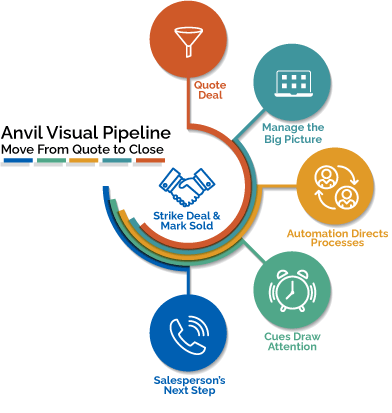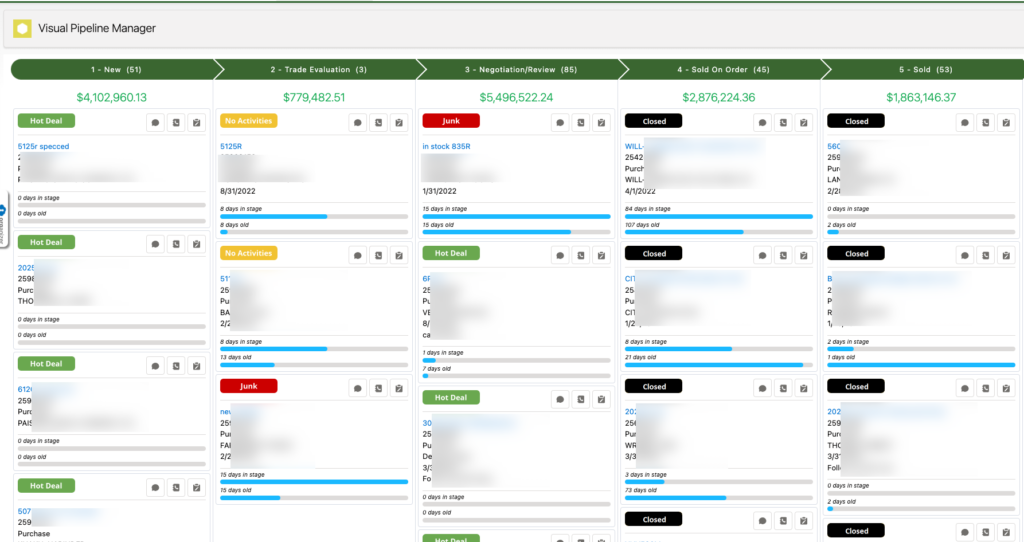11 Tips to Motivate Your Sales Team to Engage a CRM
How do you convince salespeople to use a CRM? Here are 11 ways you can motivate your sales team to adopt a CRM.
We have a solution for all equipment dealerships. Which platform is right for you?
![]() Dealer: PrairieCoast Equipment
Dealer: PrairieCoast Equipment
Locations: 10 Stores in British Columbia & Alberta, Canada
User: Jason Nichol, Interior Sales Manager

When Jason Nichol arrived at PrairieCoast Equipment, the dealership needed a solution to consolidate its sales pipeline. It tracked sales through two independent systems, neither of which included customer relations management (CRM) capability. Sales reps kept all their customer notes in personal records that existed in notebooks, phone-based notes or just in their own heads.
“Working with a system like John Deere’s JDQuote2 was great compared to working in the systems other ag manufacturers’ dealers have to work with,” says Nichol. “But, I didn’t know if the quote was provided to the customer, or if the rep had just generated a quote for reference. And there was no flow to let me know what stage the quote was at.”
Furthermore, the fast-paced, multi-tasking environment of the sales department led to inefficiencies that slowed the sales process and caused customer communication to suffer. When PrairieCoast decided to invest in a CRM, Anvil App Works stood out because of its Salesforce backbone, its dynamic Visual Sales Pipeline and its responsiveness in addressing the dealership’s needs.
The situation at PrairieCoast made managing the dealership’s sales pipeline difficult for Nichol. With as many as 9 sales people to manage, he spent large portions of each day bouncing back and forth between systems and working the phones, trying to stay on top of quotes his reps had generated and where each stood as it moved through the pipeline.
Nichol described the dealership’s pain points as follows.
Sales reps were largely left to their own devices for managing their work. This led to:
Managers spent too much valuable time and effort trying to visualize the sales pipeline. This led to:
Inexact measures of volumes and progress made reporting to general management difficult. This led to:
 The sales pipeline lies at the core of any dealership’s operations. The fact that dealers like PrairieCoast continually expend so much effort on piecing together comprehensive pipeline snapshots only proves that point.
The sales pipeline lies at the core of any dealership’s operations. The fact that dealers like PrairieCoast continually expend so much effort on piecing together comprehensive pipeline snapshots only proves that point.
“Every day, I was going to each one of the sales reps’ quotes,” says Nichol, “seeing how many quotes they generated that day, trying to follow up on quotes from previous weeks to see if purchase orders were generated from them, and trying to tally up a total amount to provide upper management a forecast of where we might close this month or quarter.”
At best, after all that effort, Nichol explained he could only create a static snapshot of the sales pipeline that often became outdated in a few hours’ time — requiring the whole process to start over again.
“I am very thankful Anvil brought this board to us. It’s the best I’ve ever had to work with,” he reports. “It gives a manager a lot of information that he doesn’t have to go asking for or searching for, and I don’t have to pepper my sales team with a lot of questions.”
Sitting atop the Salesforce CRM, Anvil harvests all the data provided by JDQuote2, as well as the customer profile and notes made by sales reps, to provide an up-to-the-minute representation of a dealership’s sales pipeline. Nichol particularly appreciates how it allows him to filter for a location, region, or single rep with only a couple of clicks, so he can quickly assess specific pieces of the pipeline.
Digitizing and centralizing all that information has transformed Nichol’s job. “All of the time I used to spend researching and chasing answers to questions is now spent supporting my sales team and working toward closing deals,” he says. “A lot of times, I can just send a quick note or text to help keep a deal moving along.”
“Anvil has been a lot easier to view,” according to Nichol. “It is more visual and more uniform.” Anvil lays all of PrairieCoast’s deals out in an array, sorting them into columns according to the dealership’s own sales-process staging. Visual, color-based cues indicate the state of each deal, while progress bars depict the deal’s lifespan. Together, they give reps and managers, alike, instantly recognizable feedback on each deal’s health.
“Once we set up a deal in JDQuote2, it automatically drops into the ‘New’ column on the board,” says Nichol. “And then, once the quote’s been presented to, reviewed with or emailed to the customer, our sales team simply drags it into the ‘Negotiation’ column. That lets us know that the customer now has the detail. At any stage, I can review that deal and see what needs to happen. Because our main goal is to get that quote into the ‘Sold’ column, right?”
PraireCoast elected to also create columns in its pipeline for ‘Trade Evaluation’, ‘Sold on Order’ and ‘Invoiced’. These columns offer more detailed insight into deals in the pipeline as well as providing segmented column totals that indicate current sales volume and revenue potential in each stage.
According to Nichol, making any business solution work starts with the team members — and that goes double for technology. “It’s only producing what you’re asking it to do and how you’re managing it,” he says. And helping team members to see how participating benefits them, personally, is crucial.
“If you make it easy for people they will do it,” he claims.
“We started out just having the guys use the game plan,” says Nichol. “And then we moved into the visual pipeline, where they could spend 5 minutes at the beginning and end of each day to plan follow-through. Instead of jumping around through three screens to get one result, Anvil has simplified that process by putting all the things we were looking to do in one place,” he explains.
“When doing performance reviews with employees, the majority of the weaknesses I see stem from time management and keeping up with the pace,” he says. “While working closely with one employee, I found when he turned the page in his notes, that was it. He just kept turning forward, never back. Think about all the opportunities he was missing.”
Anvil digitized that employee’s notebook and transformed his performance, according to Nichol. “It’s definitely allowed him to see what is there in front of him — and what he had been missing,” he says. “It took him from an average performer to well above average in his overall results. His communication has improved, as well as his stress levels. He now stays ahead of the game because he keeps track of the details and can see his next move.”
That kind of success becomes contagious.
“When you put visual cues in front of sales people and they can see what to take action on next, it brings out the best,” says Nichol. “That results in better communication, more closure and, in the end, our customer wins because somebody is communicating with them.”
Nichol attributes that transformation to the Visual Sales Pipeline. “Because once it’s there, you’ve got to manage it. That begins to instill some accountability. And I would say that in the last three years, while we’ve been using Anvil, I’ve seen nothing but growth in revenue.”

From an operations standpoint, Nichol says deploying the Visual Sales Pipeline allowed PrairieCoast to flip from reactive managing to proactive managing.
“The board allows me to look at what’s coming down the pipe, whether nine months away or six months away,” he says. “I like to make sure we are doing all we can to achieve targets and even stretch it to benchmarks, budgets and forecasting.”
Moving deals from ‘Sold’ into the ‘Invoiced’ column adds to an accumulating total of that month’s billing, explains Nichol. “I’m able to go into the VSP any time I want and see what any one of my sales team has invoiced. Plus, it allows them to keep communicating with the customers — and generally focusing on interacting with them rather than talking to the managers so much.”
The Visual Sales Pipeline has also allowed PrairieCoast to adjust quickly to changing market conditions. In the pandemic-driven environment of supply-line shortages and interruptions, the dealership asked for a new column labeled ‘Sold On Order’ to be added to its board. It shows how much volume is sold in units-on-order. Reports that break these numbers out by month or week also help the business maximize its product orders and plan its cash flow.
“We’re seeing guys get more pre-sold before it even gets here,” says Nichol. “Even deals for equipment on the lot tend to move forward more efficiently when everyone can see what is going on. If we only have two tractors of a particular model and a customer is dragging his feet on signing the deal for one of them, we have 10 locations and 42 sales guys watching the pipeline. Without a commitment, that tractor might get moved to sold from somewhere else.”
“Overall,” says Nichol, “I’m doing a better job presenting our efforts to upper management: where we’re going, how we’re tracking and how we’re going to finish.”
That’s Visual Sales Pipeline. One tool that affects productivity on every level of your business.
Learn more about Anvil’s Visual Sales Pipeline. READ»
How do you convince salespeople to use a CRM? Here are 11 ways you can motivate your sales team to adopt a CRM.
Anvil’s mobile apps put the power to get things done in the palm of your hand. Check out 4 ways mobile access enhances your dealership’s success.
Analytics are powerful tools that format data into quick-to-interpret reports and dashboards.
©Anvil App Works, LLC. All Rights Reserved.